How to Control One Light Bulb from Five or Six Different Places? – IEC & NEC
Controlling a Lamp from Five or Six Locations using 4-Way Switches (US) or Intermediate Switches (3-Way) in EU.
In today’s basic home electrical wiring installation tutorial, we will show how to wire and control a light point from six different places by using two, 2-way switches and four intermediate switches In EU, UK & IEC following countries. While the same purpose can be achieved using the same switches known as 3-Way and 4-Way Switches in North America – US – NEC.
To keep things simple and understandable, we will use the following terms which are the same things but known as different in US (NEC) and EU (IEC.
2-Way Switch & 3-Way Switch
- North America – US – NEC: SPDT (Single Pole, Double Throw ) is known as Three-Way Switch
- UK, EU & IEC Following Countries: SPDT (Single Pole, Double Throw ) is known as Two-Way Switch
3-Way Switch & 4-Way Switch
- North America – US – NEC: DPDT (Double Pole, Double Throw ) is known as 4-Way Switch or Crossover Switch. The pair of wires connecting the 4-way and 3-way switches are known as travelers.
- UK, EU & IEC Following Countries: DPDT (Double Pole, Double Throw ) is known as 3-Way Switch or Intermediate Switch. The pair of wires connecting the 3-way and 2-way switches are known as strappers.
There is no difference between 4-way switch (NEC) and 3-Way switch IEC e.g. it represents the same thing. In short, a 4-Way Switch (US) or 3-Way (Intermediate) Switch is a DPDT is a “Double Pole Double Throw” switch having four terminals.
Recommended Switches wiring tutorials to understand this configurations:
- How to Wire Single Pole, Single Throw (SPST) as 2-Way & 1-Way Switch? IEC & NEC
- How to Wire Single Pole, Double Throw (SPDT) as 3-Way & 2-Way Switch? IEC & NEC
- How to Wire DPDT as 4-Way Switch & Intermediate Switch as 3-Way
Click image to enlarge
Before going into details, we have to show the basic construction and operating mechanism of single way switch and intermediate switch.
Working & Operation Mechanism of SPDT (2-Way) Switch
Working & Operation Mechanism of Intermediate Switch
We have posted a detailed post about What is Intermediate Switch & Its Construction, Working & Uses in Electrical Wiring
An intermediate switch is commonly used in basic home electrical wiring installations i.e. staircase wiring, two-way switching, corridor & hallway wiring, hostel wiring, godown wiring, tunnel wiring, hospital wiring, three way switching as well as controlling a light point from different places with the help of using 2-way switches.
Related Posts:
Controlling a Lamp from Five Locations using 4-Way Switches & 3-Way Switches – NEC
Requirements:
- 2 No. of 3-Way Switches (SPDT = Single Pole Double Through) x 2 No
- 1 No. of Light Bulb) x 1 No
- Short pieces of wires as needed.
Procedure:
Just connect three 4-way switches in the middle of the two, 3-way switches as shown in the wiring diagam. The circuit is capable of controlling the light bulb from five different locations. You may control the lighting point from any number of places by adding additional 4-way switches in the middle of the circuit i.e. in between two, 3-way switches.
Click image to enlarge
Related Posts:
Controlling a Lamp from Six Places using 3-Way (Intermediate) Switches & 2-Way Switches – IEC
We will use two, 2-way SPDT (Single Pole Double Through) switches and four intermediate switches (3-way) to control the lamp from six different places.
Good to know: You can control a lighting point from many different places as you want by using two, 2-way switches and the required number of intermediate switches needed to control the light bulb (or any other electrical appliances) from different locations and places.
Requirements:
- Two Way Switches (SPDT = Single Pole Double Through) x 2 No
- Lamp (Light Bulb) x 1 No
- Short pieces of cables & wires x 12 No
Procedure:
Just connect four intermediate switches in the middle of the two, 2-way switches as shown in fig below. The circuit is capable of controlling the light bulb from six different places. You may control the bulb from more than six places by adding additional intermediate switches in the middle of the circuit i.e. in between two, 2-way switches.
Click image to enlarge
Working of the Circuit:
If both two-way switches are at OFF or ON position, The light bulb will switch ON and glow and the bulb may be controlled (To Switch ON or OFF) by pressing any intermediate switch. In other words, you may switch ON or OFF the light point by just pressing any switch no matter if it is the two switch or intermediate switch.
Click image to enlarge
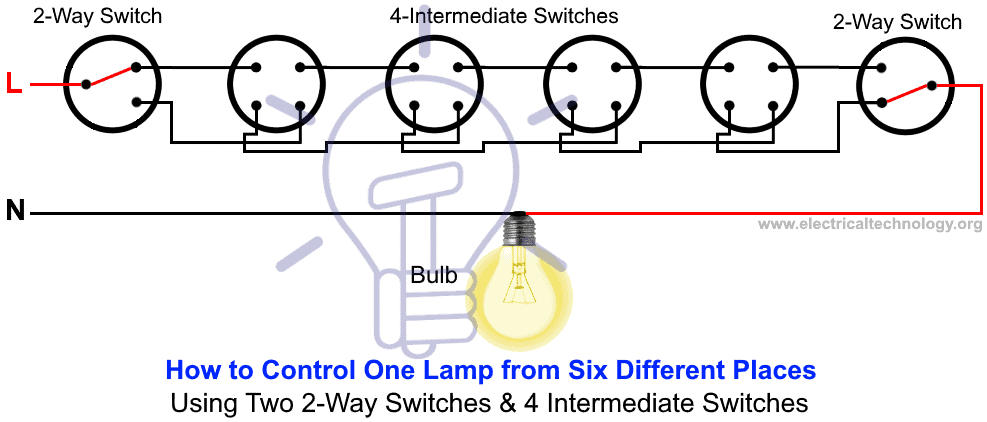
Related Posts:
- How to Control a Lamp by a Single Way or One-Way Switch?
- How to control each lamp by separately switch in parallel lighting circuit?
Good to know:
- Switches and fuses must be connected through line (Live) wire.
- More wires and cables are required in this kind of wiring connection.
- 4-Way Switches (Intermediate Switches) are a little bit expensive due to the complex internal configuration.
- 4-Ways switches are rated for 120-277V while double pole switches are rated for 240V.
Precautions:
Related Electrical Wiring Installation Tutorials Posts:
-
- How to Wire an Outlet Receptacle? Socket Outlet Wiring Diagrams
- How to Find the Number of Outlets on a Single Circuit Breaker?
- How to Find Voltage & Ampere Rating of Switch, Plug, Outlet & Receptacle
- How to Wire a Pilot Light Switch? Wiring of 2 & 3 Way Neon Light Switches
- How to Wire Combo Switch and Outlet? – Switch/Outlet Combo Wiring Diagrams
- How to Wire an AFCI Combo Switch – AFCI Switch Wiring Diagrams
- How to Wire GFCI Combo Switch and Outlet – GFCI Switch/Outlet Wiring Diagrams
- How to Control Water Heater using Switches?
- How to Wire a Ceiling Fan? Dimmer Switch and Remote Control Wiring
- How to Wire Auto & Manual Changeover & Transfer Switch – (1 & 3 Phase)
- Automatic Bathroom Light Switch Circuit Diagram and Operation
- Staircase Wiring Circuit Diagram – How to Control a Lamp from 2 Places by 2-Way Switches?
- 2 Way Switch – How to Control One Lamp From Two or Three Places?
- How to Control One Light Bulb from Six Different Places using 2-Way & Intermediate Switches?
- Corridor Wiring Circuit Diagram – Hallway Wiring using 2-Way Switches
- Hospital Wiring Circuit for Light Control using Switches
- Tunnel Wiring Circuit Diagram for Light Control using Switches
- How to Wire a UK 3-Pin Plug? Wiring a BS1363 Plug
- How to Wire a UK 3-Pin Socket Outlet? Wiring a BS1363 Socket
- How to Wire a Twin 3-Pin Socket Outlet? Wiring 2-Gang Socket
- How to Wire Combo Switch and Outlet? – Switch/Outlet Combo Wiring Diagrams
- Switch and Push Button Symbols
- Basic Electrical Wiring Diagrams
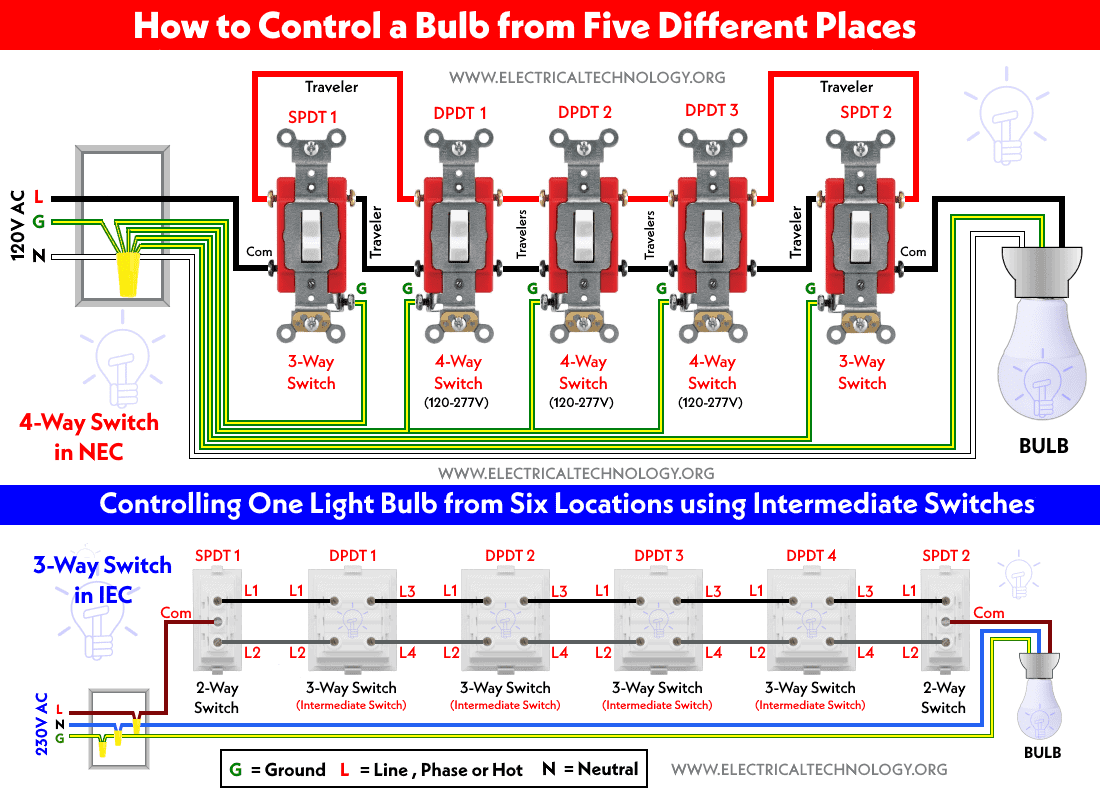
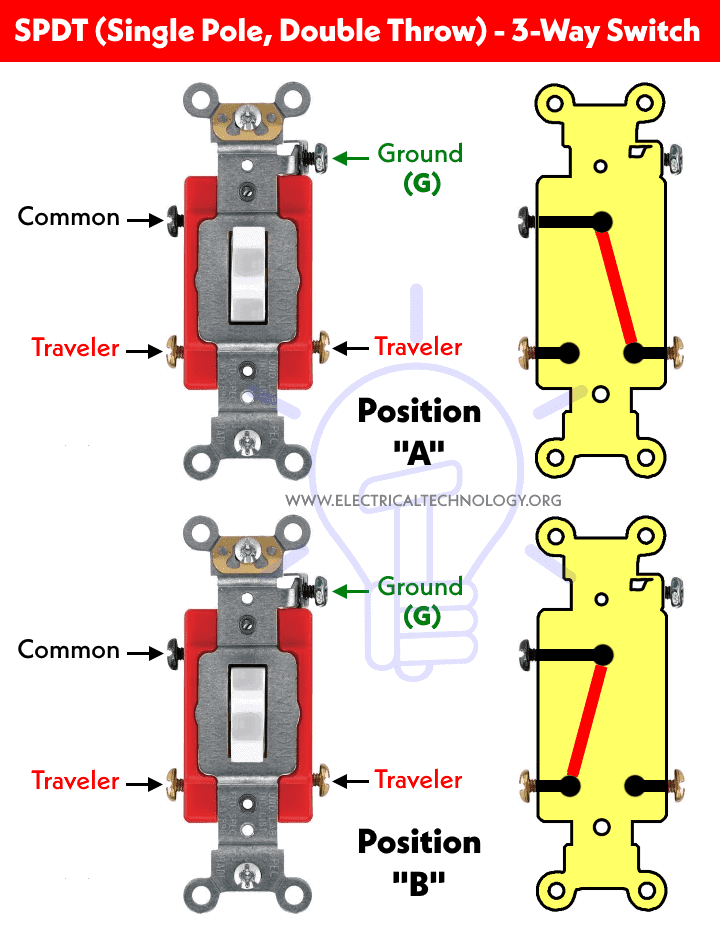
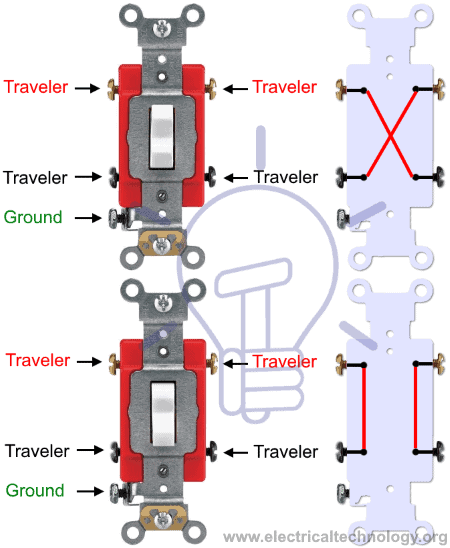
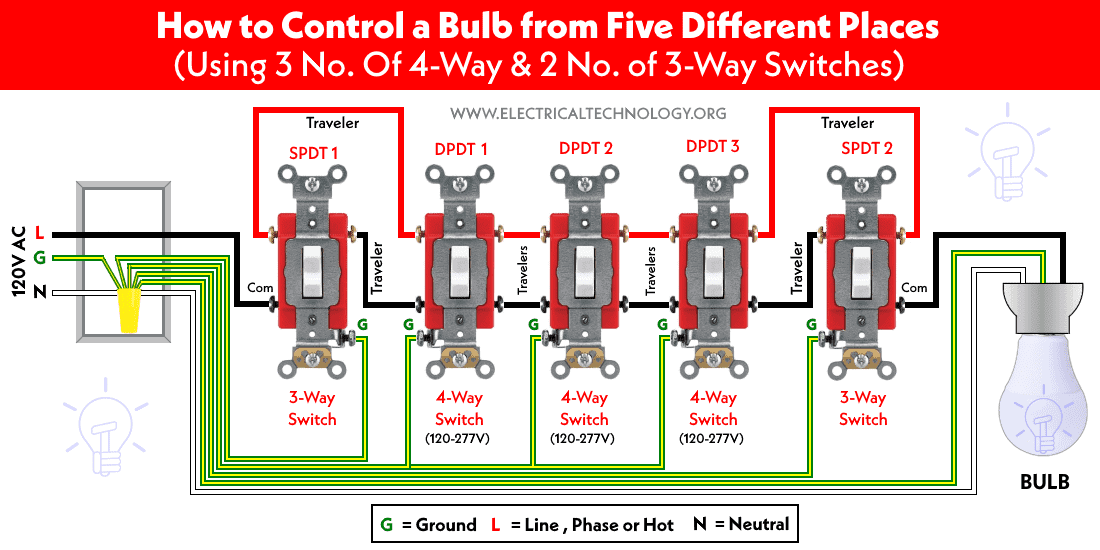








May I simply say what a relief to discover someone who really understands <br />what they are discussing online. You certainly understand how <br />to bring a problem to light and make it important. More people must read this and understand this side of the story.<br /><br />I was surprised you are not more popular because you <br />surely possess the gift.<br /><br />Feel free to visit my web
I blog often and I really appreciate your information.<br />This great article has really peaked my interest. I'm <br />going to bookmark your site and keep checking for new information about once <br />per week. I opted in for your Feed as well.<br /><br /><br />my web-site <a href="http://babvo.com" rel="nofollow">Newborn Pacifiers</a>
Its like you read my mind! You appear to know so much about this, like you wrote the <br />book in it or something. I think that you can do with <br />a few pics to drive the message home a bit, but <br />instead of that, this is excellent blog. A great read.<br />I will certainly be back.<br /><br />my website … <a href="http://xn--www-vf8l898f.jangsuto.com/zbxe/freeboard/1420121" rel="
This is really interesting, You're a very skilled blogger.<br />I have joined your rss feed and look forward to seeking more of your magnificent post.<br />Also, I've shared your site in my social networks!<br /><br />Feel free to visit my website; <a href="http://www.ircontent.ir/dl_cms/content/new-body-weight-reduction-pill-accredited-fda" rel="nofollow">diet pills</a>
this is fantatic
Thanks
Purchasing the proper magnifying light could be a struggle. It will take understanding of these special units and perhaps, individuals include not dealt with these individuals plenty of to recognise precisely what to look for a single. They are typically utilised if you have to consistently look at physical objects at length or even if you have to complete any fine job that needs people undertake
This circuit diagram is very nice . Thanks…
Completely useless. Put an X on the first 4 way switch and you will see your circuit not working.
Please explain.
Do not cross the wires at the bottom
how to control different lights individual from different points and switching all on and off from 4 places
Thank you.